Assessment Report: Entrepreneurial Venture and Mindset - BTEC Level 4
VerifiedAdded on 2020/09/27
|26
|13832
|130
Report
AI Summary
This report, submitted for a BTEC Higher National Diploma in Business (RQF) at Level 4, delves into the multifaceted world of entrepreneurship. It begins by exploring various types of entrepreneurial ventures, categorizing them into small businesses, social good organizations, large businesses, and scalable start-ups, and analyzing their distinct characteristics and objectives. The report examines the similarities and differences between these ventures, highlighting their risk profiles, capital sources, and operational structures. It then transitions to the entrepreneurial mindset, identifying key traits and skills of successful entrepreneurs, such as vision, flexibility, passion, and risk-taking, and assessing how these aspects reflect entrepreneurial motivation. The report also investigates how personal background and experience can either foster or hinder entrepreneurial endeavors. The report provides examples of different business ventures, including McDonald’s, a local catering business, a shawarma stall, and a social entrepreneurship initiative, to illustrate the concepts discussed. Finally, the report examines the influence of background and experience on entrepreneurs, by comparing and contrasting examples of how these factors can shape entrepreneurial outcomes, and concludes by summarizing the key insights from the analysis.
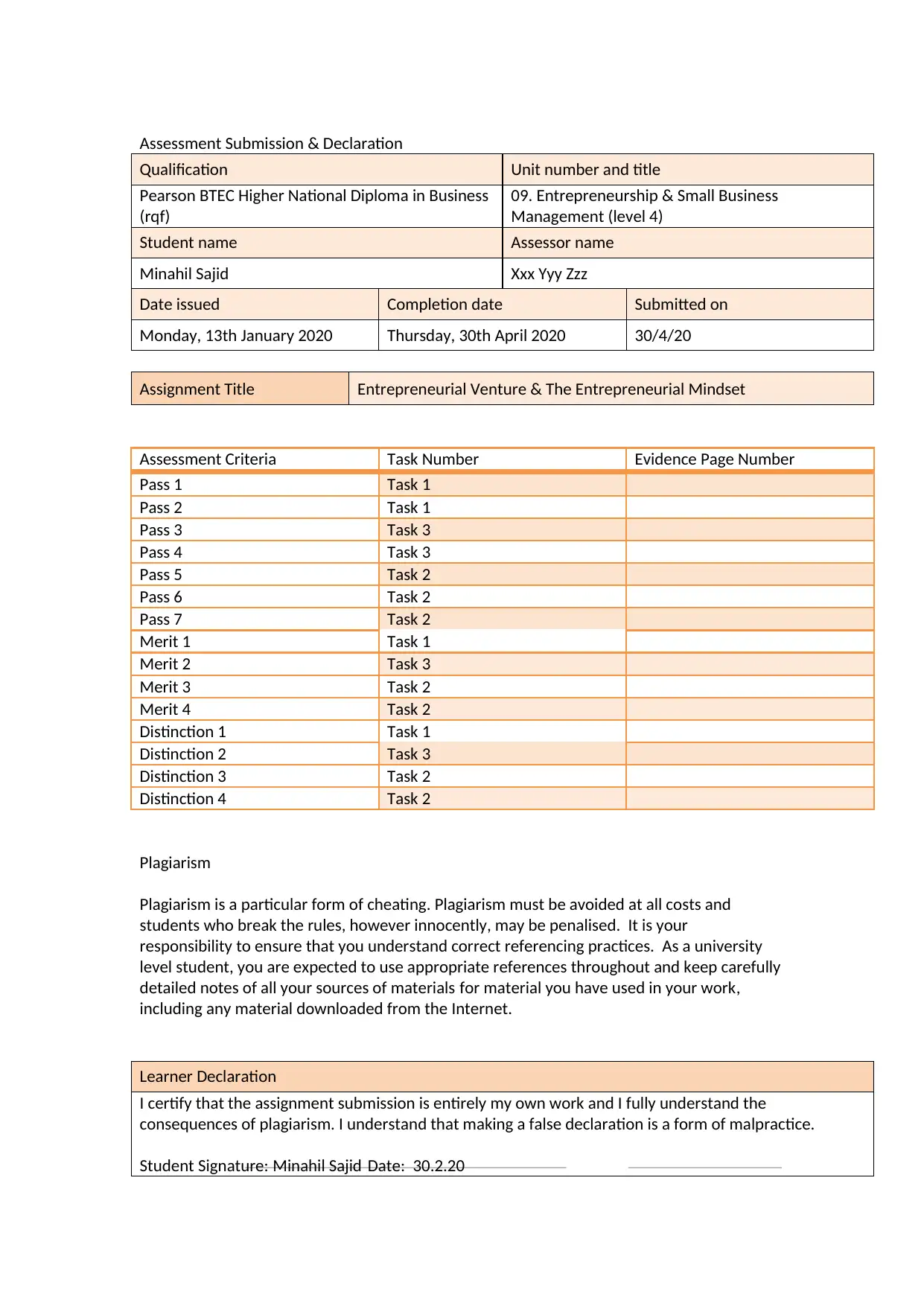
Assessment Submission & Declaration
Qualification Unit number and title
Pearson BTEC Higher National Diploma in Business
(rqf)
09. Entrepreneurship & Small Business
Management (level 4)
Student name Assessor name
Minahil Sajid Xxx Yyy Zzz
Date issued Completion date Submitted on
Monday, 13th January 2020 Thursday, 30th April 2020 30/4/20
Assignment Title Entrepreneurial Venture & The Entrepreneurial Mindset
Assessment Criteria Task Number Evidence Page Number
Pass 1 Task 1
Pass 2 Task 1
Pass 3 Task 3
Pass 4 Task 3
Pass 5 Task 2
Pass 6 Task 2
Pass 7 Task 2
Merit 1 Task 1
Merit 2 Task 3
Merit 3 Task 2
Merit 4 Task 2
Distinction 1 Task 1
Distinction 2 Task 3
Distinction 3 Task 2
Distinction 4 Task 2
Plagiarism
Plagiarism is a particular form of cheating. Plagiarism must be avoided at all costs and
students who break the rules, however innocently, may be penalised. It is your
responsibility to ensure that you understand correct referencing practices. As a university
level student, you are expected to use appropriate references throughout and keep carefully
detailed notes of all your sources of materials for material you have used in your work,
including any material downloaded from the Internet.
Learner Declaration
I certify that the assignment submission is entirely my own work and I fully understand the
consequences of plagiarism. I understand that making a false declaration is a form of malpractice.
Student Signature: Minahil Sajid Date: 30.2.20
Qualification Unit number and title
Pearson BTEC Higher National Diploma in Business
(rqf)
09. Entrepreneurship & Small Business
Management (level 4)
Student name Assessor name
Minahil Sajid Xxx Yyy Zzz
Date issued Completion date Submitted on
Monday, 13th January 2020 Thursday, 30th April 2020 30/4/20
Assignment Title Entrepreneurial Venture & The Entrepreneurial Mindset
Assessment Criteria Task Number Evidence Page Number
Pass 1 Task 1
Pass 2 Task 1
Pass 3 Task 3
Pass 4 Task 3
Pass 5 Task 2
Pass 6 Task 2
Pass 7 Task 2
Merit 1 Task 1
Merit 2 Task 3
Merit 3 Task 2
Merit 4 Task 2
Distinction 1 Task 1
Distinction 2 Task 3
Distinction 3 Task 2
Distinction 4 Task 2
Plagiarism
Plagiarism is a particular form of cheating. Plagiarism must be avoided at all costs and
students who break the rules, however innocently, may be penalised. It is your
responsibility to ensure that you understand correct referencing practices. As a university
level student, you are expected to use appropriate references throughout and keep carefully
detailed notes of all your sources of materials for material you have used in your work,
including any material downloaded from the Internet.
Learner Declaration
I certify that the assignment submission is entirely my own work and I fully understand the
consequences of plagiarism. I understand that making a false declaration is a form of malpractice.
Student Signature: Minahil Sajid Date: 30.2.20
Paraphrase This Document
Need a fresh take? Get an instant paraphrase of this document with our AI Paraphraser
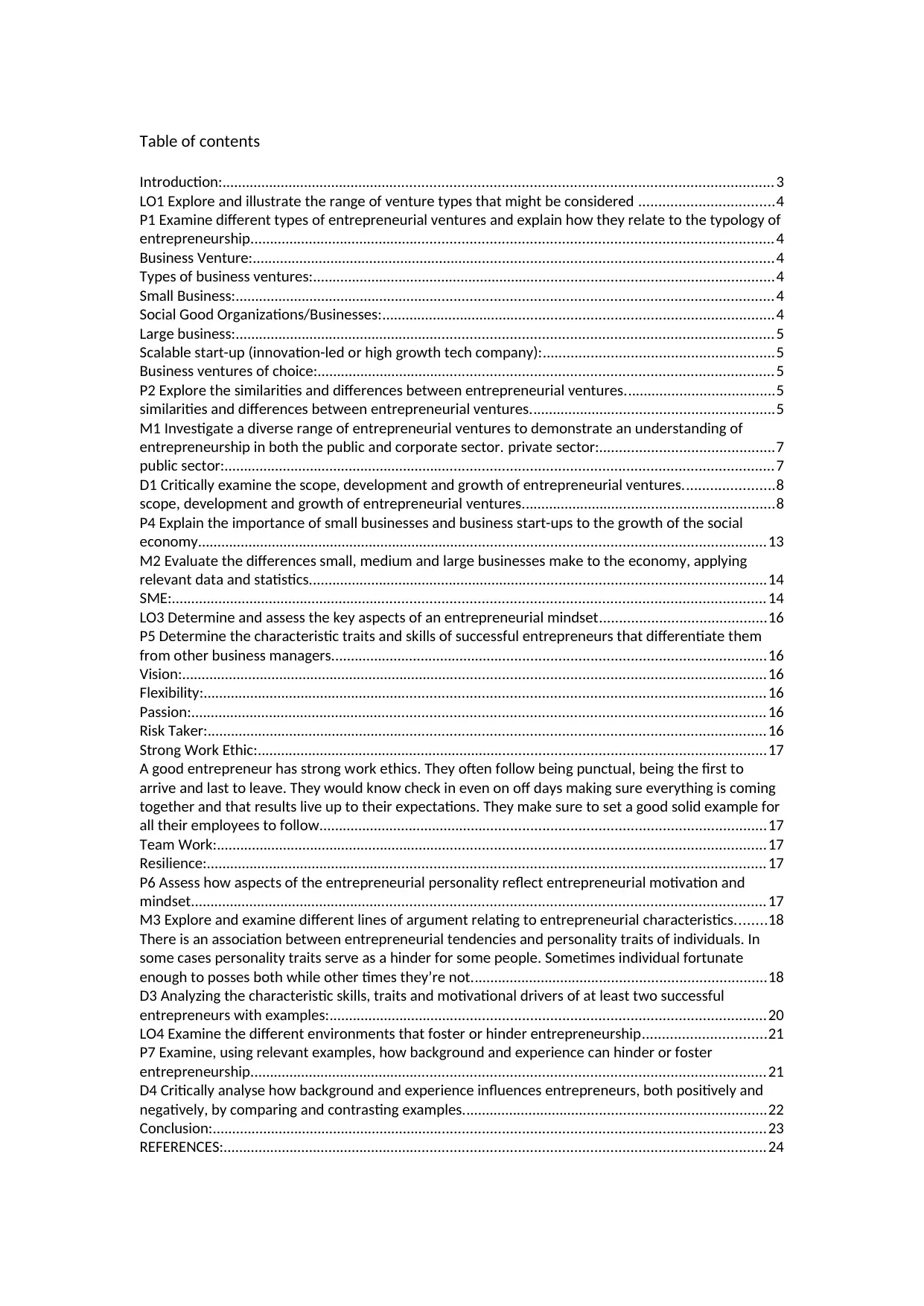
Table of contents
Introduction:........................................................................................................................................... 3
LO1 Explore and illustrate the range of venture types that might be considered ..................................4
P1 Examine different types of entrepreneurial ventures and explain how they relate to the typology of
entrepreneurship....................................................................................................................................4
Business Venture:....................................................................................................................................4
Types of business ventures:.....................................................................................................................4
Small Business:........................................................................................................................................4
Social Good Organizations/Businesses:...................................................................................................4
Large business:........................................................................................................................................5
Scalable start-up (innovation-led or high growth tech company):..........................................................5
Business ventures of choice:...................................................................................................................5
P2 Explore the similarities and differences between entrepreneurial ventures......................................5
similarities and differences between entrepreneurial ventures..............................................................5
M1 Investigate a diverse range of entrepreneurial ventures to demonstrate an understanding of
entrepreneurship in both the public and corporate sector. private sector:............................................7
public sector:...........................................................................................................................................7
D1 Critically examine the scope, development and growth of entrepreneurial ventures.......................8
scope, development and growth of entrepreneurial ventures................................................................8
P4 Explain the importance of small businesses and business start-ups to the growth of the social
economy................................................................................................................................................13
M2 Evaluate the differences small, medium and large businesses make to the economy, applying
relevant data and statistics....................................................................................................................14
SME:...................................................................................................................................................... 14
LO3 Determine and assess the key aspects of an entrepreneurial mindset..........................................16
P5 Determine the characteristic traits and skills of successful entrepreneurs that differentiate them
from other business managers..............................................................................................................16
Vision:....................................................................................................................................................16
Flexibility:..............................................................................................................................................16
Passion:................................................................................................................................................. 16
Risk Taker:.............................................................................................................................................16
Strong Work Ethic:.................................................................................................................................17
A good entrepreneur has strong work ethics. They often follow being punctual, being the first to
arrive and last to leave. They would know check in even on off days making sure everything is coming
together and that results live up to their expectations. They make sure to set a good solid example for
all their employees to follow.................................................................................................................17
Team Work:...........................................................................................................................................17
Resilience:............................................................................................................................................. 17
P6 Assess how aspects of the entrepreneurial personality reflect entrepreneurial motivation and
mindset................................................................................................................................................. 17
M3 Explore and examine different lines of argument relating to entrepreneurial characteristics........18
There is an association between entrepreneurial tendencies and personality traits of individuals. In
some cases personality traits serve as a hinder for some people. Sometimes individual fortunate
enough to posses both while other times they’re not...........................................................................18
D3 Analyzing the characteristic skills, traits and motivational drivers of at least two successful
entrepreneurs with examples:..............................................................................................................20
LO4 Examine the different environments that foster or hinder entrepreneurship...............................21
P7 Examine, using relevant examples, how background and experience can hinder or foster
entrepreneurship..................................................................................................................................21
D4 Critically analyse how background and experience influences entrepreneurs, both positively and
negatively, by comparing and contrasting examples.............................................................................22
Conclusion:............................................................................................................................................23
REFERENCES:.........................................................................................................................................24
Introduction:........................................................................................................................................... 3
LO1 Explore and illustrate the range of venture types that might be considered ..................................4
P1 Examine different types of entrepreneurial ventures and explain how they relate to the typology of
entrepreneurship....................................................................................................................................4
Business Venture:....................................................................................................................................4
Types of business ventures:.....................................................................................................................4
Small Business:........................................................................................................................................4
Social Good Organizations/Businesses:...................................................................................................4
Large business:........................................................................................................................................5
Scalable start-up (innovation-led or high growth tech company):..........................................................5
Business ventures of choice:...................................................................................................................5
P2 Explore the similarities and differences between entrepreneurial ventures......................................5
similarities and differences between entrepreneurial ventures..............................................................5
M1 Investigate a diverse range of entrepreneurial ventures to demonstrate an understanding of
entrepreneurship in both the public and corporate sector. private sector:............................................7
public sector:...........................................................................................................................................7
D1 Critically examine the scope, development and growth of entrepreneurial ventures.......................8
scope, development and growth of entrepreneurial ventures................................................................8
P4 Explain the importance of small businesses and business start-ups to the growth of the social
economy................................................................................................................................................13
M2 Evaluate the differences small, medium and large businesses make to the economy, applying
relevant data and statistics....................................................................................................................14
SME:...................................................................................................................................................... 14
LO3 Determine and assess the key aspects of an entrepreneurial mindset..........................................16
P5 Determine the characteristic traits and skills of successful entrepreneurs that differentiate them
from other business managers..............................................................................................................16
Vision:....................................................................................................................................................16
Flexibility:..............................................................................................................................................16
Passion:................................................................................................................................................. 16
Risk Taker:.............................................................................................................................................16
Strong Work Ethic:.................................................................................................................................17
A good entrepreneur has strong work ethics. They often follow being punctual, being the first to
arrive and last to leave. They would know check in even on off days making sure everything is coming
together and that results live up to their expectations. They make sure to set a good solid example for
all their employees to follow.................................................................................................................17
Team Work:...........................................................................................................................................17
Resilience:............................................................................................................................................. 17
P6 Assess how aspects of the entrepreneurial personality reflect entrepreneurial motivation and
mindset................................................................................................................................................. 17
M3 Explore and examine different lines of argument relating to entrepreneurial characteristics........18
There is an association between entrepreneurial tendencies and personality traits of individuals. In
some cases personality traits serve as a hinder for some people. Sometimes individual fortunate
enough to posses both while other times they’re not...........................................................................18
D3 Analyzing the characteristic skills, traits and motivational drivers of at least two successful
entrepreneurs with examples:..............................................................................................................20
LO4 Examine the different environments that foster or hinder entrepreneurship...............................21
P7 Examine, using relevant examples, how background and experience can hinder or foster
entrepreneurship..................................................................................................................................21
D4 Critically analyse how background and experience influences entrepreneurs, both positively and
negatively, by comparing and contrasting examples.............................................................................22
Conclusion:............................................................................................................................................23
REFERENCES:.........................................................................................................................................24

⊘ This is a preview!⊘
Do you want full access?
Subscribe today to unlock all pages.

Trusted by 1+ million students worldwide
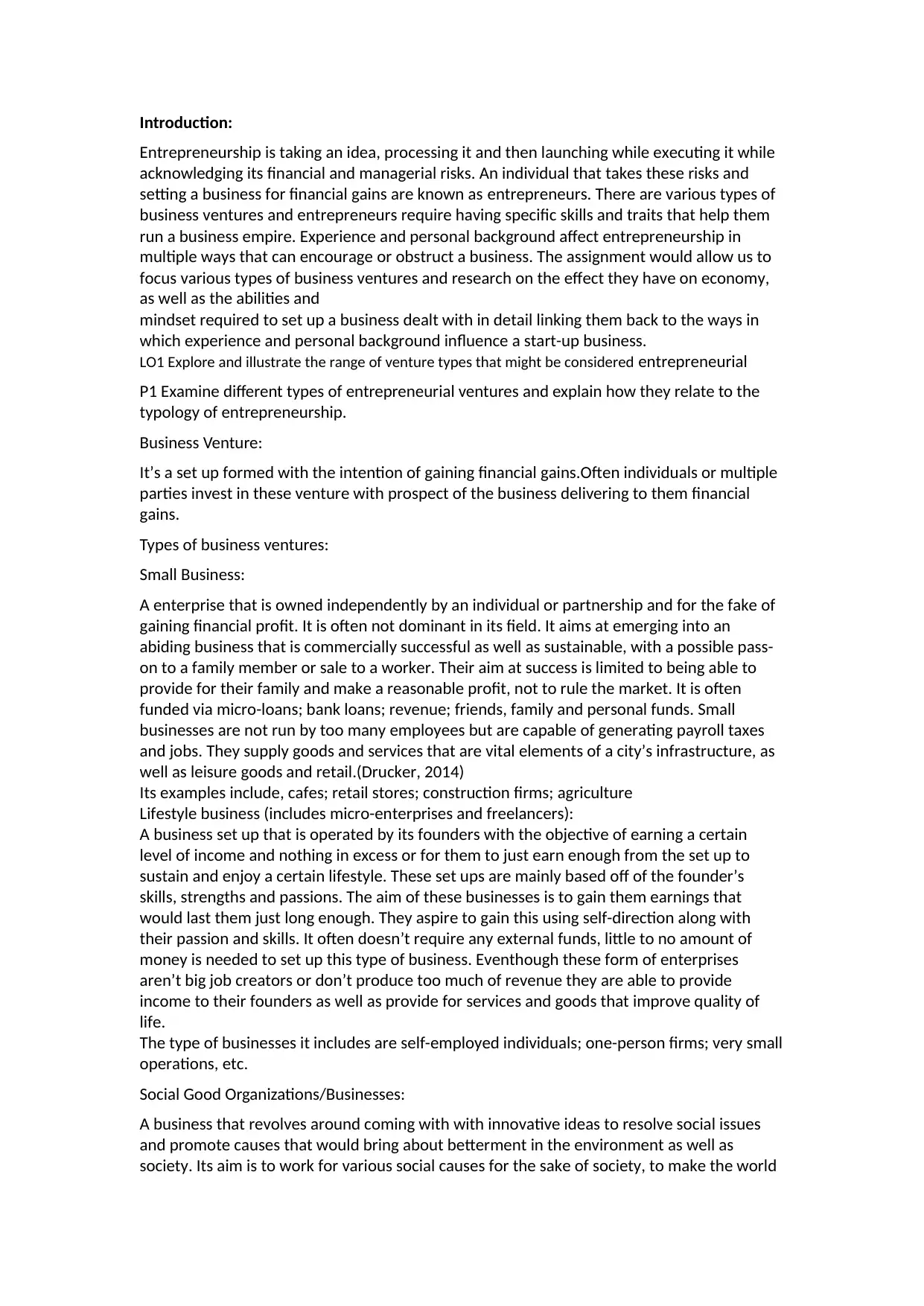
Introduction:
Entrepreneurship is taking an idea, processing it and then launching while executing it while
acknowledging its financial and managerial risks. An individual that takes these risks and
setting a business for financial gains are known as entrepreneurs. There are various types of
business ventures and entrepreneurs require having specific skills and traits that help them
run a business empire. Experience and personal background affect entrepreneurship in
multiple ways that can encourage or obstruct a business. The assignment would allow us to
focus various types of business ventures and research on the effect they have on economy,
as well as the abilities and
mindset required to set up a business dealt with in detail linking them back to the ways in
which experience and personal background influence a start-up business.
LO1 Explore and illustrate the range of venture types that might be considered entrepreneurial
P1 Examine different types of entrepreneurial ventures and explain how they relate to the
typology of entrepreneurship.
Business Venture:
It’s a set up formed with the intention of gaining financial gains.Often individuals or multiple
parties invest in these venture with prospect of the business delivering to them financial
gains.
Types of business ventures:
Small Business:
A enterprise that is owned independently by an individual or partnership and for the fake of
gaining financial profit. It is often not dominant in its field. It aims at emerging into an
abiding business that is commercially successful as well as sustainable, with a possible pass-
on to a family member or sale to a worker. Their aim at success is limited to being able to
provide for their family and make a reasonable profit, not to rule the market. It is often
funded via micro-loans; bank loans; revenue; friends, family and personal funds. Small
businesses are not run by too many employees but are capable of generating payroll taxes
and jobs. They supply goods and services that are vital elements of a city’s infrastructure, as
well as leisure goods and retail.(Drucker, 2014)
Its examples include, cafes; retail stores; construction firms; agriculture
Lifestyle business (includes micro-enterprises and freelancers):
A business set up that is operated by its founders with the objective of earning a certain
level of income and nothing in excess or for them to just earn enough from the set up to
sustain and enjoy a certain lifestyle. These set ups are mainly based off of the founder’s
skills, strengths and passions. The aim of these businesses is to gain them earnings that
would last them just long enough. They aspire to gain this using self-direction along with
their passion and skills. It often doesn’t require any external funds, little to no amount of
money is needed to set up this type of business. Eventhough these form of enterprises
aren’t big job creators or don’t produce too much of revenue they are able to provide
income to their founders as well as provide for services and goods that improve quality of
life.
The type of businesses it includes are self-employed individuals; one-person firms; very small
operations, etc.
Social Good Organizations/Businesses:
A business that revolves around coming with with innovative ideas to resolve social issues
and promote causes that would bring about betterment in the environment as well as
society. Its aim is to work for various social causes for the sake of society, to make the world
Entrepreneurship is taking an idea, processing it and then launching while executing it while
acknowledging its financial and managerial risks. An individual that takes these risks and
setting a business for financial gains are known as entrepreneurs. There are various types of
business ventures and entrepreneurs require having specific skills and traits that help them
run a business empire. Experience and personal background affect entrepreneurship in
multiple ways that can encourage or obstruct a business. The assignment would allow us to
focus various types of business ventures and research on the effect they have on economy,
as well as the abilities and
mindset required to set up a business dealt with in detail linking them back to the ways in
which experience and personal background influence a start-up business.
LO1 Explore and illustrate the range of venture types that might be considered entrepreneurial
P1 Examine different types of entrepreneurial ventures and explain how they relate to the
typology of entrepreneurship.
Business Venture:
It’s a set up formed with the intention of gaining financial gains.Often individuals or multiple
parties invest in these venture with prospect of the business delivering to them financial
gains.
Types of business ventures:
Small Business:
A enterprise that is owned independently by an individual or partnership and for the fake of
gaining financial profit. It is often not dominant in its field. It aims at emerging into an
abiding business that is commercially successful as well as sustainable, with a possible pass-
on to a family member or sale to a worker. Their aim at success is limited to being able to
provide for their family and make a reasonable profit, not to rule the market. It is often
funded via micro-loans; bank loans; revenue; friends, family and personal funds. Small
businesses are not run by too many employees but are capable of generating payroll taxes
and jobs. They supply goods and services that are vital elements of a city’s infrastructure, as
well as leisure goods and retail.(Drucker, 2014)
Its examples include, cafes; retail stores; construction firms; agriculture
Lifestyle business (includes micro-enterprises and freelancers):
A business set up that is operated by its founders with the objective of earning a certain
level of income and nothing in excess or for them to just earn enough from the set up to
sustain and enjoy a certain lifestyle. These set ups are mainly based off of the founder’s
skills, strengths and passions. The aim of these businesses is to gain them earnings that
would last them just long enough. They aspire to gain this using self-direction along with
their passion and skills. It often doesn’t require any external funds, little to no amount of
money is needed to set up this type of business. Eventhough these form of enterprises
aren’t big job creators or don’t produce too much of revenue they are able to provide
income to their founders as well as provide for services and goods that improve quality of
life.
The type of businesses it includes are self-employed individuals; one-person firms; very small
operations, etc.
Social Good Organizations/Businesses:
A business that revolves around coming with with innovative ideas to resolve social issues
and promote causes that would bring about betterment in the environment as well as
society. Its aim is to work for various social causes for the sake of society, to make the world
Paraphrase This Document
Need a fresh take? Get an instant paraphrase of this document with our AI Paraphraser
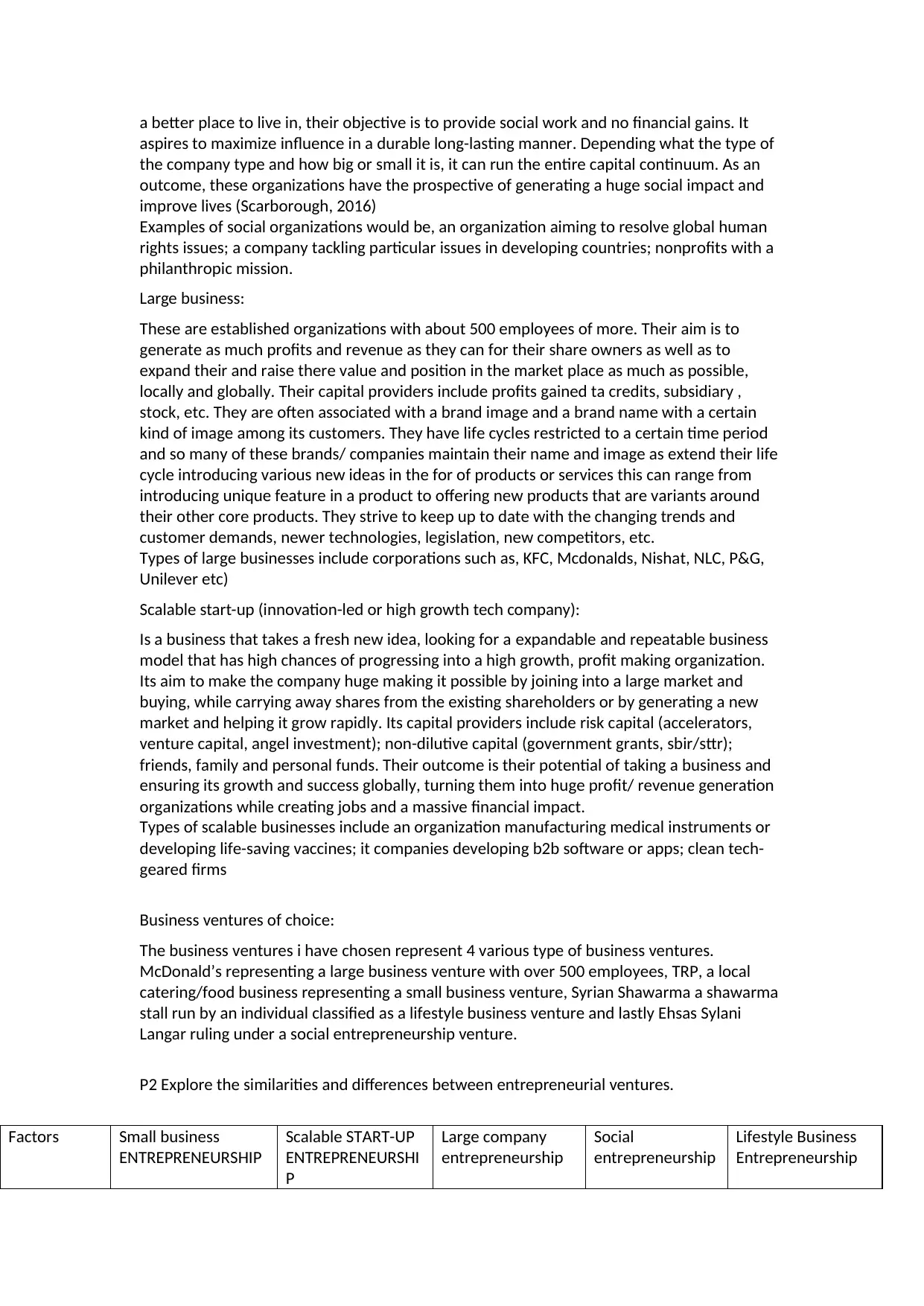
a better place to live in, their objective is to provide social work and no financial gains. It
aspires to maximize influence in a durable long-lasting manner. Depending what the type of
the company type and how big or small it is, it can run the entire capital continuum. As an
outcome, these organizations have the prospective of generating a huge social impact and
improve lives (Scarborough, 2016)
Examples of social organizations would be, an organization aiming to resolve global human
rights issues; a company tackling particular issues in developing countries; nonprofits with a
philanthropic mission.
Large business:
These are established organizations with about 500 employees of more. Their aim is to
generate as much profits and revenue as they can for their share owners as well as to
expand their and raise there value and position in the market place as much as possible,
locally and globally. Their capital providers include profits gained ta credits, subsidiary ,
stock, etc. They are often associated with a brand image and a brand name with a certain
kind of image among its customers. They have life cycles restricted to a certain time period
and so many of these brands/ companies maintain their name and image as extend their life
cycle introducing various new ideas in the for of products or services this can range from
introducing unique feature in a product to offering new products that are variants around
their other core products. They strive to keep up to date with the changing trends and
customer demands, newer technologies, legislation, new competitors, etc.
Types of large businesses include corporations such as, KFC, Mcdonalds, Nishat, NLC, P&G,
Unilever etc)
Scalable start-up (innovation-led or high growth tech company):
Is a business that takes a fresh new idea, looking for a expandable and repeatable business
model that has high chances of progressing into a high growth, profit making organization.
Its aim to make the company huge making it possible by joining into a large market and
buying, while carrying away shares from the existing shareholders or by generating a new
market and helping it grow rapidly. Its capital providers include risk capital (accelerators,
venture capital, angel investment); non-dilutive capital (government grants, sbir/sttr);
friends, family and personal funds. Their outcome is their potential of taking a business and
ensuring its growth and success globally, turning them into huge profit/ revenue generation
organizations while creating jobs and a massive financial impact.
Types of scalable businesses include an organization manufacturing medical instruments or
developing life-saving vaccines; it companies developing b2b software or apps; clean tech-
geared firms
Business ventures of choice:
The business ventures i have chosen represent 4 various type of business ventures.
McDonald’s representing a large business venture with over 500 employees, TRP, a local
catering/food business representing a small business venture, Syrian Shawarma a shawarma
stall run by an individual classified as a lifestyle business venture and lastly Ehsas Sylani
Langar ruling under a social entrepreneurship venture.
P2 Explore the similarities and differences between entrepreneurial ventures.
Factors Small business
ENTREPRENEURSHIP
Scalable START-UP
ENTREPRENEURSHI
P
Large company
entrepreneurship
Social
entrepreneurship
Lifestyle Business
Entrepreneurship
aspires to maximize influence in a durable long-lasting manner. Depending what the type of
the company type and how big or small it is, it can run the entire capital continuum. As an
outcome, these organizations have the prospective of generating a huge social impact and
improve lives (Scarborough, 2016)
Examples of social organizations would be, an organization aiming to resolve global human
rights issues; a company tackling particular issues in developing countries; nonprofits with a
philanthropic mission.
Large business:
These are established organizations with about 500 employees of more. Their aim is to
generate as much profits and revenue as they can for their share owners as well as to
expand their and raise there value and position in the market place as much as possible,
locally and globally. Their capital providers include profits gained ta credits, subsidiary ,
stock, etc. They are often associated with a brand image and a brand name with a certain
kind of image among its customers. They have life cycles restricted to a certain time period
and so many of these brands/ companies maintain their name and image as extend their life
cycle introducing various new ideas in the for of products or services this can range from
introducing unique feature in a product to offering new products that are variants around
their other core products. They strive to keep up to date with the changing trends and
customer demands, newer technologies, legislation, new competitors, etc.
Types of large businesses include corporations such as, KFC, Mcdonalds, Nishat, NLC, P&G,
Unilever etc)
Scalable start-up (innovation-led or high growth tech company):
Is a business that takes a fresh new idea, looking for a expandable and repeatable business
model that has high chances of progressing into a high growth, profit making organization.
Its aim to make the company huge making it possible by joining into a large market and
buying, while carrying away shares from the existing shareholders or by generating a new
market and helping it grow rapidly. Its capital providers include risk capital (accelerators,
venture capital, angel investment); non-dilutive capital (government grants, sbir/sttr);
friends, family and personal funds. Their outcome is their potential of taking a business and
ensuring its growth and success globally, turning them into huge profit/ revenue generation
organizations while creating jobs and a massive financial impact.
Types of scalable businesses include an organization manufacturing medical instruments or
developing life-saving vaccines; it companies developing b2b software or apps; clean tech-
geared firms
Business ventures of choice:
The business ventures i have chosen represent 4 various type of business ventures.
McDonald’s representing a large business venture with over 500 employees, TRP, a local
catering/food business representing a small business venture, Syrian Shawarma a shawarma
stall run by an individual classified as a lifestyle business venture and lastly Ehsas Sylani
Langar ruling under a social entrepreneurship venture.
P2 Explore the similarities and differences between entrepreneurial ventures.
Factors Small business
ENTREPRENEURSHIP
Scalable START-UP
ENTREPRENEURSHI
P
Large company
entrepreneurship
Social
entrepreneurship
Lifestyle Business
Entrepreneurship
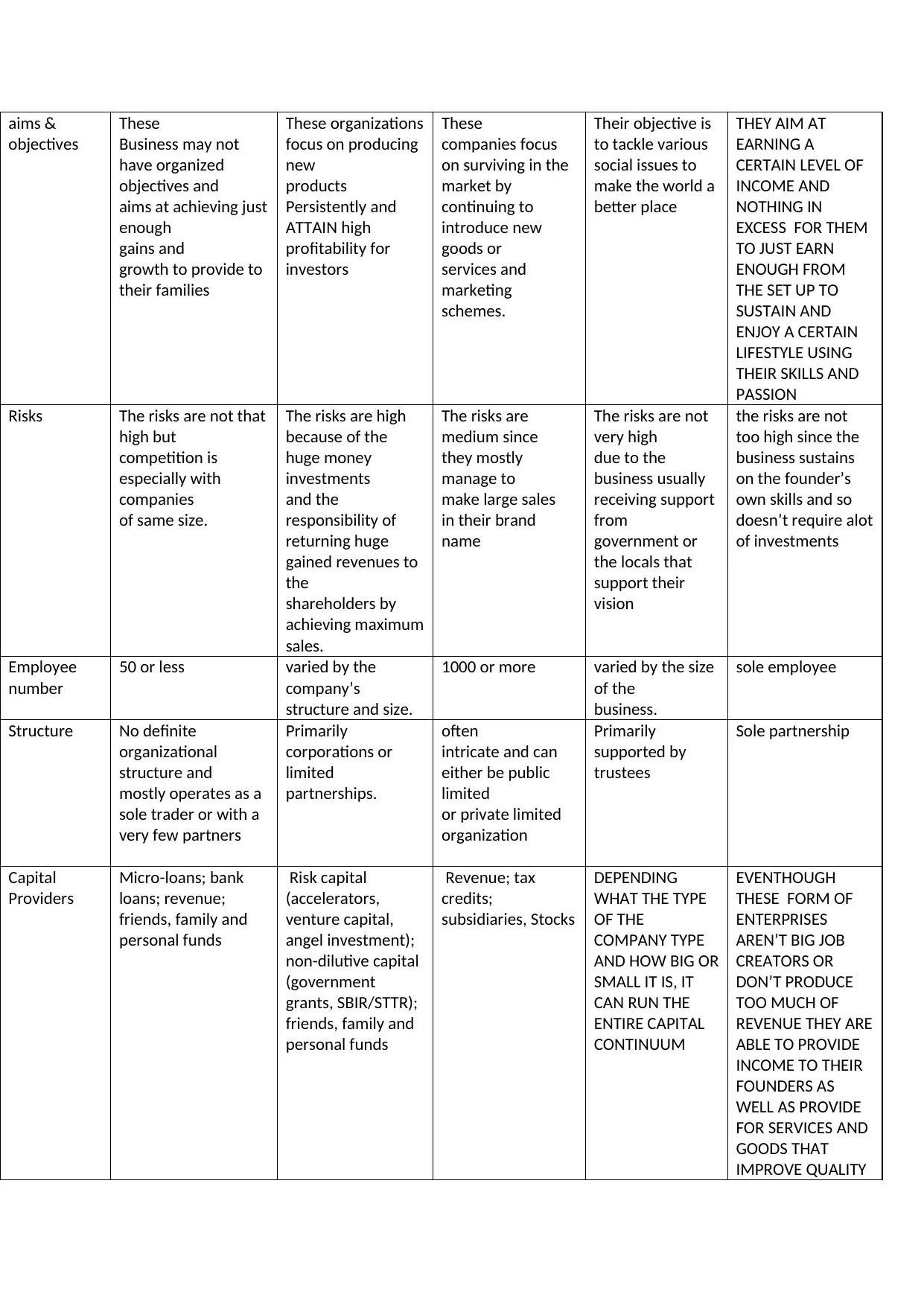
aims &
objectives
These
Business may not
have organized
objectives and
aims at achieving just
enough
gains and
growth to provide to
their families
These organizations
focus on producing
new
products
Persistently and
ATTAIN high
profitability for
investors
These
companies focus
on surviving in the
market by
continuing to
introduce new
goods or
services and
marketing
schemes.
Their objective is
to tackle various
social issues to
make the world a
better place
THEY AIM AT
EARNING A
CERTAIN LEVEL OF
INCOME AND
NOTHING IN
EXCESS FOR THEM
TO JUST EARN
ENOUGH FROM
THE SET UP TO
SUSTAIN AND
ENJOY A CERTAIN
LIFESTYLE USING
THEIR SKILLS AND
PASSION
Risks The risks are not that
high but
competition is
especially with
companies
of same size.
The risks are high
because of the
huge money
investments
and the
responsibility of
returning huge
gained revenues to
the
shareholders by
achieving maximum
sales.
The risks are
medium since
they mostly
manage to
make large sales
in their brand
name
The risks are not
very high
due to the
business usually
receiving support
from
government or
the locals that
support their
vision
the risks are not
too high since the
business sustains
on the founder’s
own skills and so
doesn’t require alot
of investments
Employee
number
50 or less varied by the
company’s
structure and size.
1000 or more varied by the size
of the
business.
sole employee
Structure No definite
organizational
structure and
mostly operates as a
sole trader or with a
very few partners
Primarily
corporations or
limited
partnerships.
often
intricate and can
either be public
limited
or private limited
organization
Primarily
supported by
trustees
Sole partnership
Capital
Providers
Micro-loans; bank
loans; revenue;
friends, family and
personal funds
Risk capital
(accelerators,
venture capital,
angel investment);
non-dilutive capital
(government
grants, SBIR/STTR);
friends, family and
personal funds
Revenue; tax
credits;
subsidiaries, Stocks
DEPENDING
WHAT THE TYPE
OF THE
COMPANY TYPE
AND HOW BIG OR
SMALL IT IS, IT
CAN RUN THE
ENTIRE CAPITAL
CONTINUUM
EVENTHOUGH
THESE FORM OF
ENTERPRISES
AREN’T BIG JOB
CREATORS OR
DON’T PRODUCE
TOO MUCH OF
REVENUE THEY ARE
ABLE TO PROVIDE
INCOME TO THEIR
FOUNDERS AS
WELL AS PROVIDE
FOR SERVICES AND
GOODS THAT
IMPROVE QUALITY
objectives
These
Business may not
have organized
objectives and
aims at achieving just
enough
gains and
growth to provide to
their families
These organizations
focus on producing
new
products
Persistently and
ATTAIN high
profitability for
investors
These
companies focus
on surviving in the
market by
continuing to
introduce new
goods or
services and
marketing
schemes.
Their objective is
to tackle various
social issues to
make the world a
better place
THEY AIM AT
EARNING A
CERTAIN LEVEL OF
INCOME AND
NOTHING IN
EXCESS FOR THEM
TO JUST EARN
ENOUGH FROM
THE SET UP TO
SUSTAIN AND
ENJOY A CERTAIN
LIFESTYLE USING
THEIR SKILLS AND
PASSION
Risks The risks are not that
high but
competition is
especially with
companies
of same size.
The risks are high
because of the
huge money
investments
and the
responsibility of
returning huge
gained revenues to
the
shareholders by
achieving maximum
sales.
The risks are
medium since
they mostly
manage to
make large sales
in their brand
name
The risks are not
very high
due to the
business usually
receiving support
from
government or
the locals that
support their
vision
the risks are not
too high since the
business sustains
on the founder’s
own skills and so
doesn’t require alot
of investments
Employee
number
50 or less varied by the
company’s
structure and size.
1000 or more varied by the size
of the
business.
sole employee
Structure No definite
organizational
structure and
mostly operates as a
sole trader or with a
very few partners
Primarily
corporations or
limited
partnerships.
often
intricate and can
either be public
limited
or private limited
organization
Primarily
supported by
trustees
Sole partnership
Capital
Providers
Micro-loans; bank
loans; revenue;
friends, family and
personal funds
Risk capital
(accelerators,
venture capital,
angel investment);
non-dilutive capital
(government
grants, SBIR/STTR);
friends, family and
personal funds
Revenue; tax
credits;
subsidiaries, Stocks
DEPENDING
WHAT THE TYPE
OF THE
COMPANY TYPE
AND HOW BIG OR
SMALL IT IS, IT
CAN RUN THE
ENTIRE CAPITAL
CONTINUUM
EVENTHOUGH
THESE FORM OF
ENTERPRISES
AREN’T BIG JOB
CREATORS OR
DON’T PRODUCE
TOO MUCH OF
REVENUE THEY ARE
ABLE TO PROVIDE
INCOME TO THEIR
FOUNDERS AS
WELL AS PROVIDE
FOR SERVICES AND
GOODS THAT
IMPROVE QUALITY
⊘ This is a preview!⊘
Do you want full access?
Subscribe today to unlock all pages.

Trusted by 1+ million students worldwide
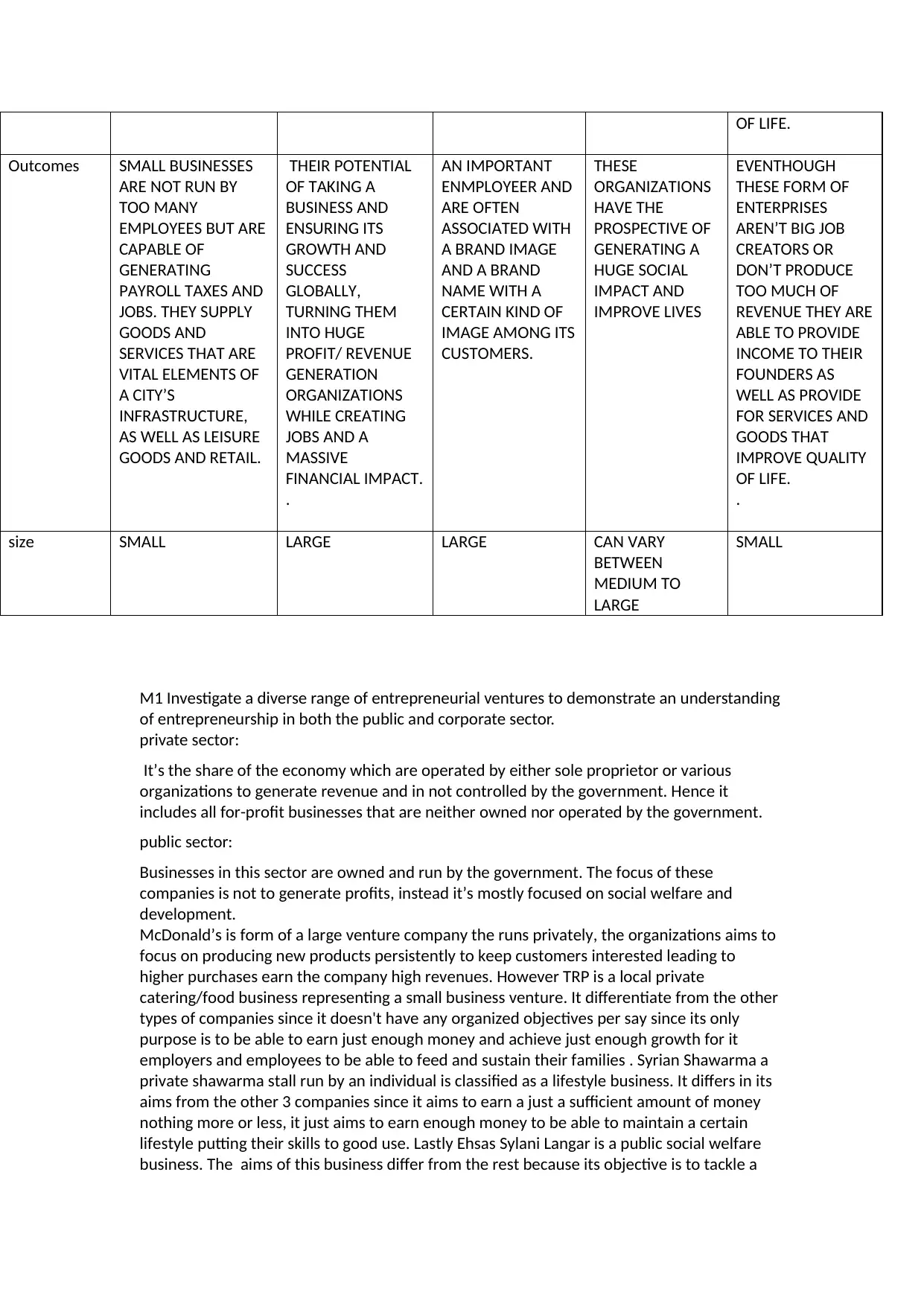
OF LIFE.
Outcomes SMALL BUSINESSES
ARE NOT RUN BY
TOO MANY
EMPLOYEES BUT ARE
CAPABLE OF
GENERATING
PAYROLL TAXES AND
JOBS. THEY SUPPLY
GOODS AND
SERVICES THAT ARE
VITAL ELEMENTS OF
A CITY’S
INFRASTRUCTURE,
AS WELL AS LEISURE
GOODS AND RETAIL.
THEIR POTENTIAL
OF TAKING A
BUSINESS AND
ENSURING ITS
GROWTH AND
SUCCESS
GLOBALLY,
TURNING THEM
INTO HUGE
PROFIT/ REVENUE
GENERATION
ORGANIZATIONS
WHILE CREATING
JOBS AND A
MASSIVE
FINANCIAL IMPACT.
.
AN IMPORTANT
ENMPLOYEER AND
ARE OFTEN
ASSOCIATED WITH
A BRAND IMAGE
AND A BRAND
NAME WITH A
CERTAIN KIND OF
IMAGE AMONG ITS
CUSTOMERS.
THESE
ORGANIZATIONS
HAVE THE
PROSPECTIVE OF
GENERATING A
HUGE SOCIAL
IMPACT AND
IMPROVE LIVES
EVENTHOUGH
THESE FORM OF
ENTERPRISES
AREN’T BIG JOB
CREATORS OR
DON’T PRODUCE
TOO MUCH OF
REVENUE THEY ARE
ABLE TO PROVIDE
INCOME TO THEIR
FOUNDERS AS
WELL AS PROVIDE
FOR SERVICES AND
GOODS THAT
IMPROVE QUALITY
OF LIFE.
.
size SMALL LARGE LARGE CAN VARY
BETWEEN
MEDIUM TO
LARGE
SMALL
M1 Investigate a diverse range of entrepreneurial ventures to demonstrate an understanding
of entrepreneurship in both the public and corporate sector.
private sector:
It’s the share of the economy which are operated by either sole proprietor or various
organizations to generate revenue and in not controlled by the government. Hence it
includes all for-profit businesses that are neither owned nor operated by the government.
public sector:
Businesses in this sector are owned and run by the government. The focus of these
companies is not to generate profits, instead it’s mostly focused on social welfare and
development.
McDonald’s is form of a large venture company the runs privately, the organizations aims to
focus on producing new products persistently to keep customers interested leading to
higher purchases earn the company high revenues. However TRP is a local private
catering/food business representing a small business venture. It differentiate from the other
types of companies since it doesn't have any organized objectives per say since its only
purpose is to be able to earn just enough money and achieve just enough growth for it
employers and employees to be able to feed and sustain their families . Syrian Shawarma a
private shawarma stall run by an individual is classified as a lifestyle business. It differs in its
aims from the other 3 companies since it aims to earn a just a sufficient amount of money
nothing more or less, it just aims to earn enough money to be able to maintain a certain
lifestyle putting their skills to good use. Lastly Ehsas Sylani Langar is a public social welfare
business. The aims of this business differ from the rest because its objective is to tackle a
Outcomes SMALL BUSINESSES
ARE NOT RUN BY
TOO MANY
EMPLOYEES BUT ARE
CAPABLE OF
GENERATING
PAYROLL TAXES AND
JOBS. THEY SUPPLY
GOODS AND
SERVICES THAT ARE
VITAL ELEMENTS OF
A CITY’S
INFRASTRUCTURE,
AS WELL AS LEISURE
GOODS AND RETAIL.
THEIR POTENTIAL
OF TAKING A
BUSINESS AND
ENSURING ITS
GROWTH AND
SUCCESS
GLOBALLY,
TURNING THEM
INTO HUGE
PROFIT/ REVENUE
GENERATION
ORGANIZATIONS
WHILE CREATING
JOBS AND A
MASSIVE
FINANCIAL IMPACT.
.
AN IMPORTANT
ENMPLOYEER AND
ARE OFTEN
ASSOCIATED WITH
A BRAND IMAGE
AND A BRAND
NAME WITH A
CERTAIN KIND OF
IMAGE AMONG ITS
CUSTOMERS.
THESE
ORGANIZATIONS
HAVE THE
PROSPECTIVE OF
GENERATING A
HUGE SOCIAL
IMPACT AND
IMPROVE LIVES
EVENTHOUGH
THESE FORM OF
ENTERPRISES
AREN’T BIG JOB
CREATORS OR
DON’T PRODUCE
TOO MUCH OF
REVENUE THEY ARE
ABLE TO PROVIDE
INCOME TO THEIR
FOUNDERS AS
WELL AS PROVIDE
FOR SERVICES AND
GOODS THAT
IMPROVE QUALITY
OF LIFE.
.
size SMALL LARGE LARGE CAN VARY
BETWEEN
MEDIUM TO
LARGE
SMALL
M1 Investigate a diverse range of entrepreneurial ventures to demonstrate an understanding
of entrepreneurship in both the public and corporate sector.
private sector:
It’s the share of the economy which are operated by either sole proprietor or various
organizations to generate revenue and in not controlled by the government. Hence it
includes all for-profit businesses that are neither owned nor operated by the government.
public sector:
Businesses in this sector are owned and run by the government. The focus of these
companies is not to generate profits, instead it’s mostly focused on social welfare and
development.
McDonald’s is form of a large venture company the runs privately, the organizations aims to
focus on producing new products persistently to keep customers interested leading to
higher purchases earn the company high revenues. However TRP is a local private
catering/food business representing a small business venture. It differentiate from the other
types of companies since it doesn't have any organized objectives per say since its only
purpose is to be able to earn just enough money and achieve just enough growth for it
employers and employees to be able to feed and sustain their families . Syrian Shawarma a
private shawarma stall run by an individual is classified as a lifestyle business. It differs in its
aims from the other 3 companies since it aims to earn a just a sufficient amount of money
nothing more or less, it just aims to earn enough money to be able to maintain a certain
lifestyle putting their skills to good use. Lastly Ehsas Sylani Langar is a public social welfare
business. The aims of this business differ from the rest because its objective is to tackle a
Paraphrase This Document
Need a fresh take? Get an instant paraphrase of this document with our AI Paraphraser
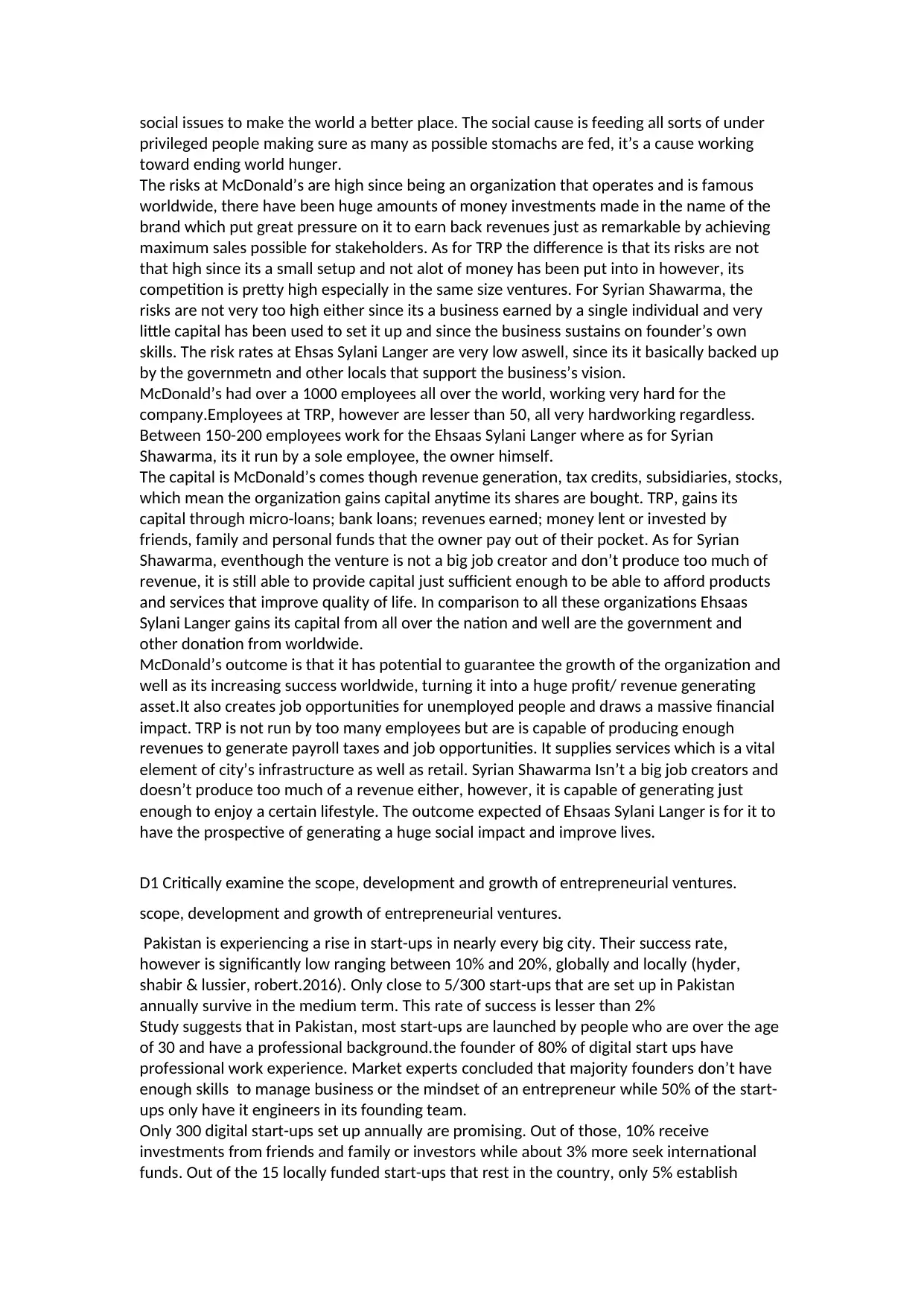
social issues to make the world a better place. The social cause is feeding all sorts of under
privileged people making sure as many as possible stomachs are fed, it’s a cause working
toward ending world hunger.
The risks at McDonald’s are high since being an organization that operates and is famous
worldwide, there have been huge amounts of money investments made in the name of the
brand which put great pressure on it to earn back revenues just as remarkable by achieving
maximum sales possible for stakeholders. As for TRP the difference is that its risks are not
that high since its a small setup and not alot of money has been put into in however, its
competition is pretty high especially in the same size ventures. For Syrian Shawarma, the
risks are not very too high either since its a business earned by a single individual and very
little capital has been used to set it up and since the business sustains on founder’s own
skills. The risk rates at Ehsas Sylani Langer are very low aswell, since its it basically backed up
by the governmetn and other locals that support the business’s vision.
McDonald’s had over a 1000 employees all over the world, working very hard for the
company.Employees at TRP, however are lesser than 50, all very hardworking regardless.
Between 150-200 employees work for the Ehsaas Sylani Langer where as for Syrian
Shawarma, its it run by a sole employee, the owner himself.
The capital is McDonald’s comes though revenue generation, tax credits, subsidiaries, stocks,
which mean the organization gains capital anytime its shares are bought. TRP, gains its
capital through micro-loans; bank loans; revenues earned; money lent or invested by
friends, family and personal funds that the owner pay out of their pocket. As for Syrian
Shawarma, eventhough the venture is not a big job creator and don’t produce too much of
revenue, it is still able to provide capital just sufficient enough to be able to afford products
and services that improve quality of life. In comparison to all these organizations Ehsaas
Sylani Langer gains its capital from all over the nation and well are the government and
other donation from worldwide.
McDonald’s outcome is that it has potential to guarantee the growth of the organization and
well as its increasing success worldwide, turning it into a huge profit/ revenue generating
asset.It also creates job opportunities for unemployed people and draws a massive financial
impact. TRP is not run by too many employees but are is capable of producing enough
revenues to generate payroll taxes and job opportunities. It supplies services which is a vital
element of city’s infrastructure as well as retail. Syrian Shawarma Isn’t a big job creators and
doesn’t produce too much of a revenue either, however, it is capable of generating just
enough to enjoy a certain lifestyle. The outcome expected of Ehsaas Sylani Langer is for it to
have the prospective of generating a huge social impact and improve lives.
D1 Critically examine the scope, development and growth of entrepreneurial ventures.
scope, development and growth of entrepreneurial ventures.
Pakistan is experiencing a rise in start-ups in nearly every big city. Their success rate,
however is significantly low ranging between 10% and 20%, globally and locally (hyder,
shabir & lussier, robert.2016). Only close to 5/300 start-ups that are set up in Pakistan
annually survive in the medium term. This rate of success is lesser than 2%
Study suggests that in Pakistan, most start-ups are launched by people who are over the age
of 30 and have a professional background.the founder of 80% of digital start ups have
professional work experience. Market experts concluded that majority founders don’t have
enough skills to manage business or the mindset of an entrepreneur while 50% of the start-
ups only have it engineers in its founding team.
Only 300 digital start-ups set up annually are promising. Out of those, 10% receive
investments from friends and family or investors while about 3% more seek international
funds. Out of the 15 locally funded start-ups that rest in the country, only 5% establish
privileged people making sure as many as possible stomachs are fed, it’s a cause working
toward ending world hunger.
The risks at McDonald’s are high since being an organization that operates and is famous
worldwide, there have been huge amounts of money investments made in the name of the
brand which put great pressure on it to earn back revenues just as remarkable by achieving
maximum sales possible for stakeholders. As for TRP the difference is that its risks are not
that high since its a small setup and not alot of money has been put into in however, its
competition is pretty high especially in the same size ventures. For Syrian Shawarma, the
risks are not very too high either since its a business earned by a single individual and very
little capital has been used to set it up and since the business sustains on founder’s own
skills. The risk rates at Ehsas Sylani Langer are very low aswell, since its it basically backed up
by the governmetn and other locals that support the business’s vision.
McDonald’s had over a 1000 employees all over the world, working very hard for the
company.Employees at TRP, however are lesser than 50, all very hardworking regardless.
Between 150-200 employees work for the Ehsaas Sylani Langer where as for Syrian
Shawarma, its it run by a sole employee, the owner himself.
The capital is McDonald’s comes though revenue generation, tax credits, subsidiaries, stocks,
which mean the organization gains capital anytime its shares are bought. TRP, gains its
capital through micro-loans; bank loans; revenues earned; money lent or invested by
friends, family and personal funds that the owner pay out of their pocket. As for Syrian
Shawarma, eventhough the venture is not a big job creator and don’t produce too much of
revenue, it is still able to provide capital just sufficient enough to be able to afford products
and services that improve quality of life. In comparison to all these organizations Ehsaas
Sylani Langer gains its capital from all over the nation and well are the government and
other donation from worldwide.
McDonald’s outcome is that it has potential to guarantee the growth of the organization and
well as its increasing success worldwide, turning it into a huge profit/ revenue generating
asset.It also creates job opportunities for unemployed people and draws a massive financial
impact. TRP is not run by too many employees but are is capable of producing enough
revenues to generate payroll taxes and job opportunities. It supplies services which is a vital
element of city’s infrastructure as well as retail. Syrian Shawarma Isn’t a big job creators and
doesn’t produce too much of a revenue either, however, it is capable of generating just
enough to enjoy a certain lifestyle. The outcome expected of Ehsaas Sylani Langer is for it to
have the prospective of generating a huge social impact and improve lives.
D1 Critically examine the scope, development and growth of entrepreneurial ventures.
scope, development and growth of entrepreneurial ventures.
Pakistan is experiencing a rise in start-ups in nearly every big city. Their success rate,
however is significantly low ranging between 10% and 20%, globally and locally (hyder,
shabir & lussier, robert.2016). Only close to 5/300 start-ups that are set up in Pakistan
annually survive in the medium term. This rate of success is lesser than 2%
Study suggests that in Pakistan, most start-ups are launched by people who are over the age
of 30 and have a professional background.the founder of 80% of digital start ups have
professional work experience. Market experts concluded that majority founders don’t have
enough skills to manage business or the mindset of an entrepreneur while 50% of the start-
ups only have it engineers in its founding team.
Only 300 digital start-ups set up annually are promising. Out of those, 10% receive
investments from friends and family or investors while about 3% more seek international
funds. Out of the 15 locally funded start-ups that rest in the country, only 5% establish
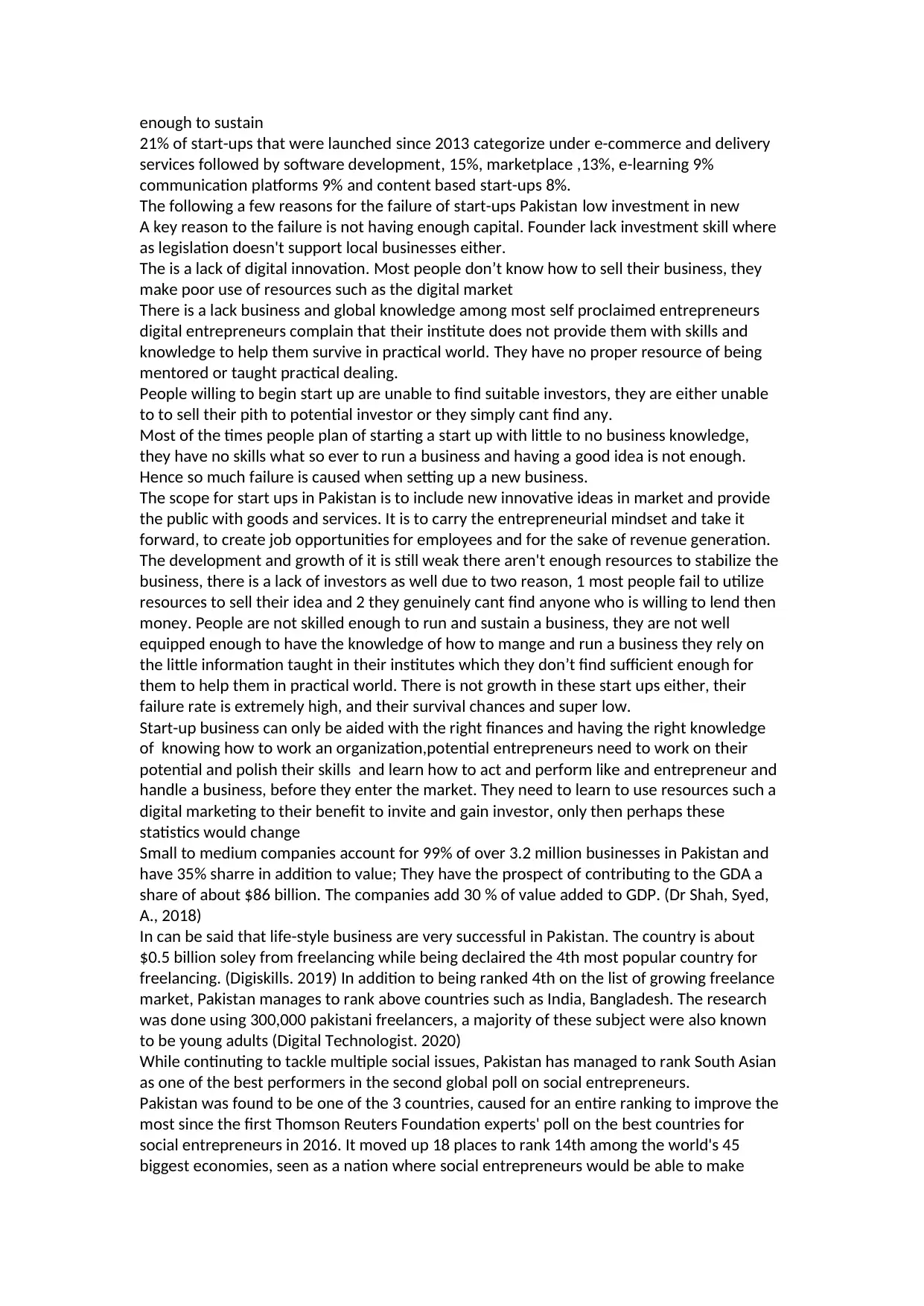
enough to sustain
21% of start-ups that were launched since 2013 categorize under e-commerce and delivery
services followed by software development, 15%, marketplace ,13%, e-learning 9%
communication platforms 9% and content based start-ups 8%.
The following a few reasons for the failure of start-ups Pakistan low investment in new
A key reason to the failure is not having enough capital. Founder lack investment skill where
as legislation doesn't support local businesses either.
The is a lack of digital innovation. Most people don’t know how to sell their business, they
make poor use of resources such as the digital market
There is a lack business and global knowledge among most self proclaimed entrepreneurs
digital entrepreneurs complain that their institute does not provide them with skills and
knowledge to help them survive in practical world. They have no proper resource of being
mentored or taught practical dealing.
People willing to begin start up are unable to find suitable investors, they are either unable
to to sell their pith to potential investor or they simply cant find any.
Most of the times people plan of starting a start up with little to no business knowledge,
they have no skills what so ever to run a business and having a good idea is not enough.
Hence so much failure is caused when setting up a new business.
The scope for start ups in Pakistan is to include new innovative ideas in market and provide
the public with goods and services. It is to carry the entrepreneurial mindset and take it
forward, to create job opportunities for employees and for the sake of revenue generation.
The development and growth of it is still weak there aren't enough resources to stabilize the
business, there is a lack of investors as well due to two reason, 1 most people fail to utilize
resources to sell their idea and 2 they genuinely cant find anyone who is willing to lend then
money. People are not skilled enough to run and sustain a business, they are not well
equipped enough to have the knowledge of how to mange and run a business they rely on
the little information taught in their institutes which they don’t find sufficient enough for
them to help them in practical world. There is not growth in these start ups either, their
failure rate is extremely high, and their survival chances and super low.
Start-up business can only be aided with the right finances and having the right knowledge
of knowing how to work an organization,potential entrepreneurs need to work on their
potential and polish their skills and learn how to act and perform like and entrepreneur and
handle a business, before they enter the market. They need to learn to use resources such a
digital marketing to their benefit to invite and gain investor, only then perhaps these
statistics would change
Small to medium companies account for 99% of over 3.2 million businesses in Pakistan and
have 35% sharre in addition to value; They have the prospect of contributing to the GDA a
share of about $86 billion. The companies add 30 % of value added to GDP. (Dr Shah, Syed,
A., 2018)
In can be said that life-style business are very successful in Pakistan. The country is about
$0.5 billion soley from freelancing while being declaired the 4th most popular country for
freelancing. (Digiskills. 2019) In addition to being ranked 4th on the list of growing freelance
market, Pakistan manages to rank above countries such as India, Bangladesh. The research
was done using 300,000 pakistani freelancers, a majority of these subject were also known
to be young adults (Digital Technologist. 2020)
While continuting to tackle multiple social issues, Pakistan has managed to rank South Asian
as one of the best performers in the second global poll on social entrepreneurs.
Pakistan was found to be one of the 3 countries, caused for an entire ranking to improve the
most since the first Thomson Reuters Foundation experts' poll on the best countries for
social entrepreneurs in 2016. It moved up 18 places to rank 14th among the world's 45
biggest economies, seen as a nation where social entrepreneurs would be able to make
21% of start-ups that were launched since 2013 categorize under e-commerce and delivery
services followed by software development, 15%, marketplace ,13%, e-learning 9%
communication platforms 9% and content based start-ups 8%.
The following a few reasons for the failure of start-ups Pakistan low investment in new
A key reason to the failure is not having enough capital. Founder lack investment skill where
as legislation doesn't support local businesses either.
The is a lack of digital innovation. Most people don’t know how to sell their business, they
make poor use of resources such as the digital market
There is a lack business and global knowledge among most self proclaimed entrepreneurs
digital entrepreneurs complain that their institute does not provide them with skills and
knowledge to help them survive in practical world. They have no proper resource of being
mentored or taught practical dealing.
People willing to begin start up are unable to find suitable investors, they are either unable
to to sell their pith to potential investor or they simply cant find any.
Most of the times people plan of starting a start up with little to no business knowledge,
they have no skills what so ever to run a business and having a good idea is not enough.
Hence so much failure is caused when setting up a new business.
The scope for start ups in Pakistan is to include new innovative ideas in market and provide
the public with goods and services. It is to carry the entrepreneurial mindset and take it
forward, to create job opportunities for employees and for the sake of revenue generation.
The development and growth of it is still weak there aren't enough resources to stabilize the
business, there is a lack of investors as well due to two reason, 1 most people fail to utilize
resources to sell their idea and 2 they genuinely cant find anyone who is willing to lend then
money. People are not skilled enough to run and sustain a business, they are not well
equipped enough to have the knowledge of how to mange and run a business they rely on
the little information taught in their institutes which they don’t find sufficient enough for
them to help them in practical world. There is not growth in these start ups either, their
failure rate is extremely high, and their survival chances and super low.
Start-up business can only be aided with the right finances and having the right knowledge
of knowing how to work an organization,potential entrepreneurs need to work on their
potential and polish their skills and learn how to act and perform like and entrepreneur and
handle a business, before they enter the market. They need to learn to use resources such a
digital marketing to their benefit to invite and gain investor, only then perhaps these
statistics would change
Small to medium companies account for 99% of over 3.2 million businesses in Pakistan and
have 35% sharre in addition to value; They have the prospect of contributing to the GDA a
share of about $86 billion. The companies add 30 % of value added to GDP. (Dr Shah, Syed,
A., 2018)
In can be said that life-style business are very successful in Pakistan. The country is about
$0.5 billion soley from freelancing while being declaired the 4th most popular country for
freelancing. (Digiskills. 2019) In addition to being ranked 4th on the list of growing freelance
market, Pakistan manages to rank above countries such as India, Bangladesh. The research
was done using 300,000 pakistani freelancers, a majority of these subject were also known
to be young adults (Digital Technologist. 2020)
While continuting to tackle multiple social issues, Pakistan has managed to rank South Asian
as one of the best performers in the second global poll on social entrepreneurs.
Pakistan was found to be one of the 3 countries, caused for an entire ranking to improve the
most since the first Thomson Reuters Foundation experts' poll on the best countries for
social entrepreneurs in 2016. It moved up 18 places to rank 14th among the world's 45
biggest economies, seen as a nation where social entrepreneurs would be able to make
⊘ This is a preview!⊘
Do you want full access?
Subscribe today to unlock all pages.

Trusted by 1+ million students worldwide
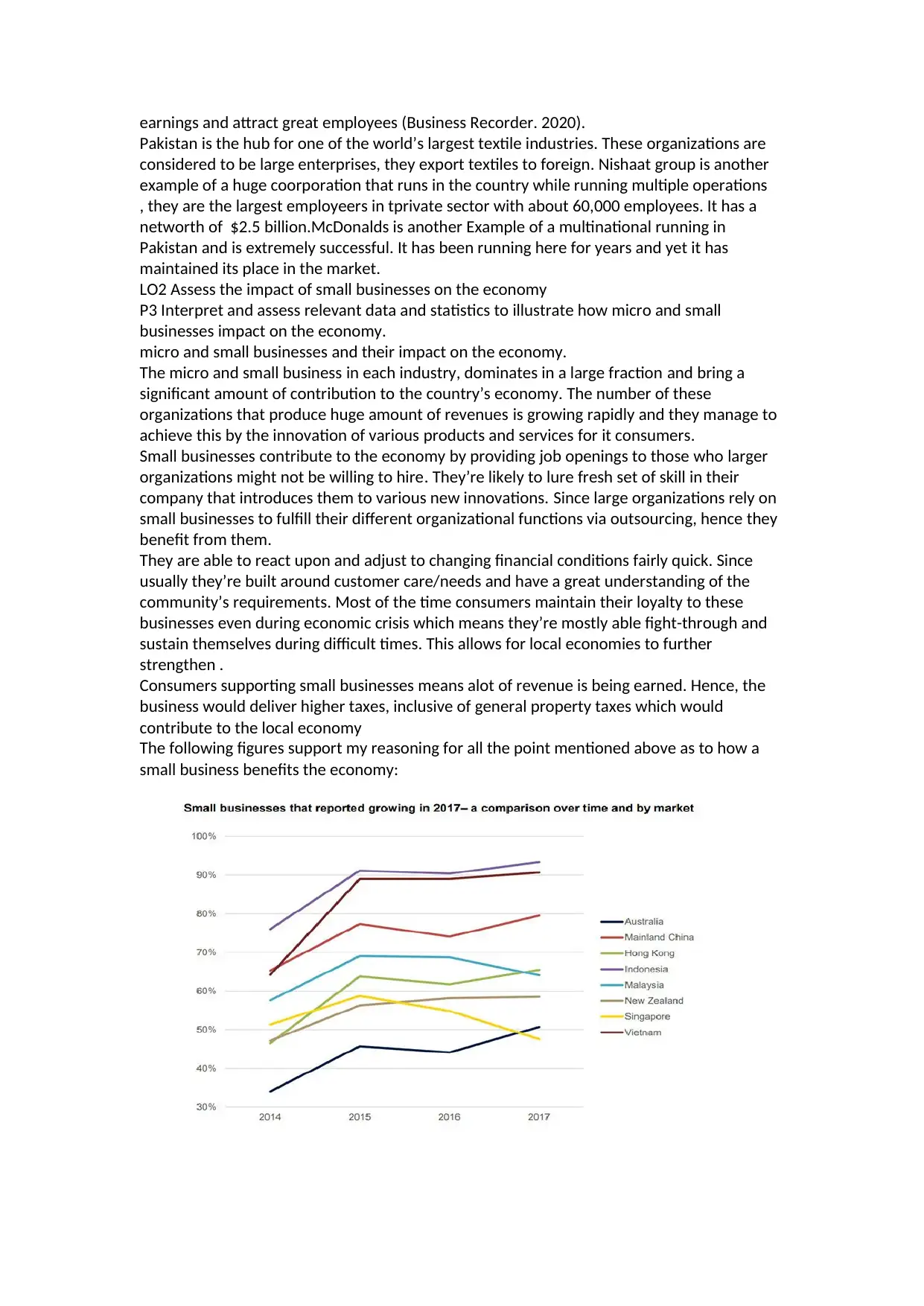
earnings and attract great employees (Business Recorder. 2020).
Pakistan is the hub for one of the world’s largest textile industries. These organizations are
considered to be large enterprises, they export textiles to foreign. Nishaat group is another
example of a huge coorporation that runs in the country while running multiple operations
, they are the largest employeers in tprivate sector with about 60,000 employees. It has a
networth of $2.5 billion.McDonalds is another Example of a multinational running in
Pakistan and is extremely successful. It has been running here for years and yet it has
maintained its place in the market.
LO2 Assess the impact of small businesses on the economy
P3 Interpret and assess relevant data and statistics to illustrate how micro and small
businesses impact on the economy.
micro and small businesses and their impact on the economy.
The micro and small business in each industry, dominates in a large fraction and bring a
significant amount of contribution to the country’s economy. The number of these
organizations that produce huge amount of revenues is growing rapidly and they manage to
achieve this by the innovation of various products and services for it consumers.
Small businesses contribute to the economy by providing job openings to those who larger
organizations might not be willing to hire. They’re likely to lure fresh set of skill in their
company that introduces them to various new innovations. Since large organizations rely on
small businesses to fulfill their different organizational functions via outsourcing, hence they
benefit from them.
They are able to react upon and adjust to changing financial conditions fairly quick. Since
usually they’re built around customer care/needs and have a great understanding of the
community’s requirements. Most of the time consumers maintain their loyalty to these
businesses even during economic crisis which means they’re mostly able fight-through and
sustain themselves during difficult times. This allows for local economies to further
strengthen .
Consumers supporting small businesses means alot of revenue is being earned. Hence, the
business would deliver higher taxes, inclusive of general property taxes which would
contribute to the local economy
The following figures support my reasoning for all the point mentioned above as to how a
small business benefits the economy:
Pakistan is the hub for one of the world’s largest textile industries. These organizations are
considered to be large enterprises, they export textiles to foreign. Nishaat group is another
example of a huge coorporation that runs in the country while running multiple operations
, they are the largest employeers in tprivate sector with about 60,000 employees. It has a
networth of $2.5 billion.McDonalds is another Example of a multinational running in
Pakistan and is extremely successful. It has been running here for years and yet it has
maintained its place in the market.
LO2 Assess the impact of small businesses on the economy
P3 Interpret and assess relevant data and statistics to illustrate how micro and small
businesses impact on the economy.
micro and small businesses and their impact on the economy.
The micro and small business in each industry, dominates in a large fraction and bring a
significant amount of contribution to the country’s economy. The number of these
organizations that produce huge amount of revenues is growing rapidly and they manage to
achieve this by the innovation of various products and services for it consumers.
Small businesses contribute to the economy by providing job openings to those who larger
organizations might not be willing to hire. They’re likely to lure fresh set of skill in their
company that introduces them to various new innovations. Since large organizations rely on
small businesses to fulfill their different organizational functions via outsourcing, hence they
benefit from them.
They are able to react upon and adjust to changing financial conditions fairly quick. Since
usually they’re built around customer care/needs and have a great understanding of the
community’s requirements. Most of the time consumers maintain their loyalty to these
businesses even during economic crisis which means they’re mostly able fight-through and
sustain themselves during difficult times. This allows for local economies to further
strengthen .
Consumers supporting small businesses means alot of revenue is being earned. Hence, the
business would deliver higher taxes, inclusive of general property taxes which would
contribute to the local economy
The following figures support my reasoning for all the point mentioned above as to how a
small business benefits the economy:
Paraphrase This Document
Need a fresh take? Get an instant paraphrase of this document with our AI Paraphraser
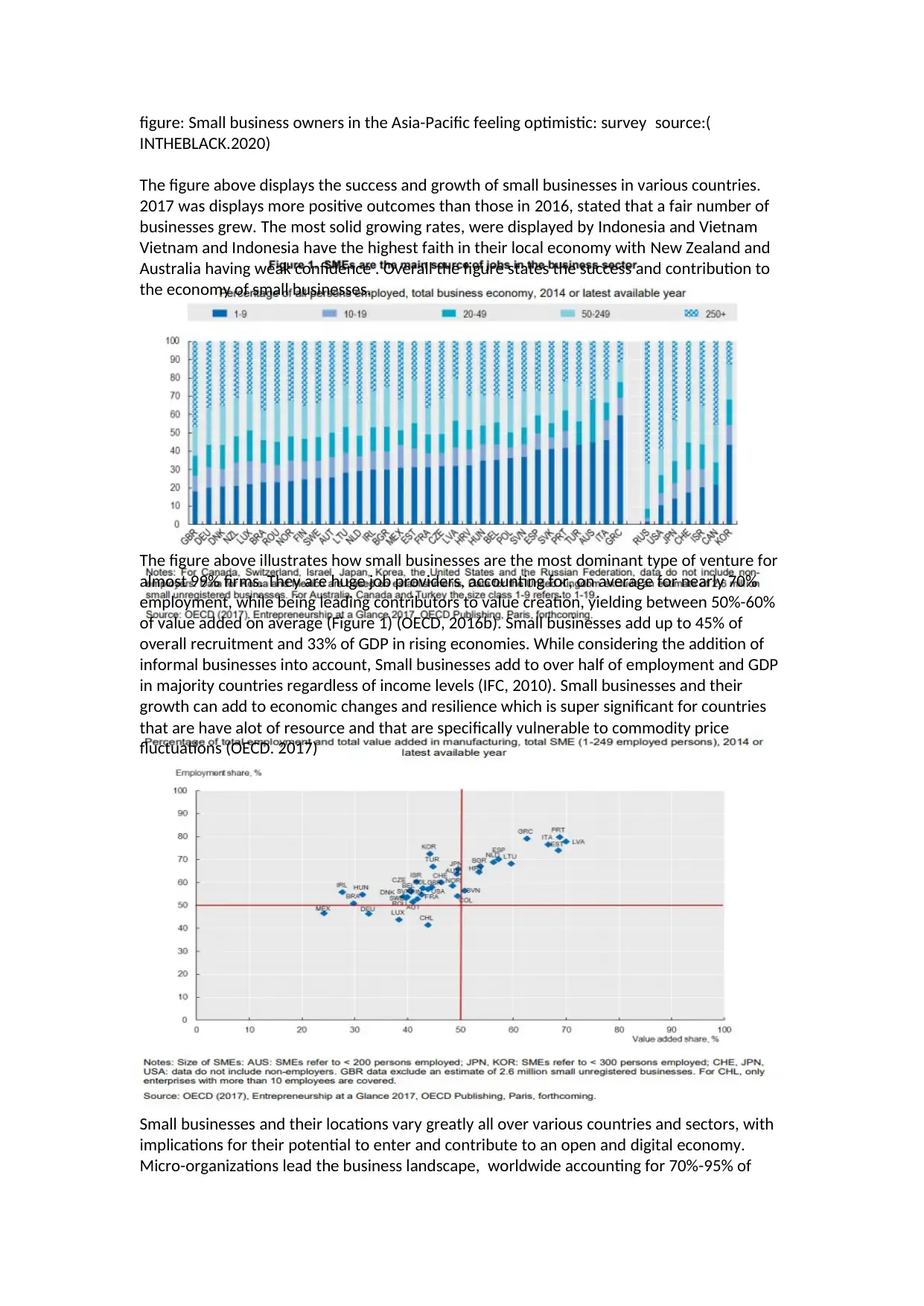
figure: Small business owners in the Asia-Pacific feeling optimistic: survey source:(
INTHEBLACK.2020)
The figure above displays the success and growth of small businesses in various countries.
2017 was displays more positive outcomes than those in 2016, stated that a fair number of
businesses grew. The most solid growing rates, were displayed by Indonesia and Vietnam
Vietnam and Indonesia have the highest faith in their local economy with New Zealand and
Australia having weak confidence . Overall the figure states the success and contribution to
the economy of small businesses.
The figure above illustrates how small businesses are the most dominant type of venture for
almost 99% firms. They are huge job providers, accounting for, on average for nearly 70%
employment, while being leading contributors to value creation, yielding between 50%-60%
of value added on average (Figure 1) (OECD, 2016b). Small businesses add up to 45% of
overall recruitment and 33% of GDP in rising economies. While considering the addition of
informal businesses into account, Small businesses add to over half of employment and GDP
in majority countries regardless of income levels (IFC, 2010). Small businesses and their
growth can add to economic changes and resilience which is super significant for countries
that are have alot of resource and that are specifically vulnerable to commodity price
fluctuations (OECD. 2017)
Small businesses and their locations vary greatly all over various countries and sectors, with
implications for their potential to enter and contribute to an open and digital economy.
Micro-organizations lead the business landscape, worldwide accounting for 70%-95% of
INTHEBLACK.2020)
The figure above displays the success and growth of small businesses in various countries.
2017 was displays more positive outcomes than those in 2016, stated that a fair number of
businesses grew. The most solid growing rates, were displayed by Indonesia and Vietnam
Vietnam and Indonesia have the highest faith in their local economy with New Zealand and
Australia having weak confidence . Overall the figure states the success and contribution to
the economy of small businesses.
The figure above illustrates how small businesses are the most dominant type of venture for
almost 99% firms. They are huge job providers, accounting for, on average for nearly 70%
employment, while being leading contributors to value creation, yielding between 50%-60%
of value added on average (Figure 1) (OECD, 2016b). Small businesses add up to 45% of
overall recruitment and 33% of GDP in rising economies. While considering the addition of
informal businesses into account, Small businesses add to over half of employment and GDP
in majority countries regardless of income levels (IFC, 2010). Small businesses and their
growth can add to economic changes and resilience which is super significant for countries
that are have alot of resource and that are specifically vulnerable to commodity price
fluctuations (OECD. 2017)
Small businesses and their locations vary greatly all over various countries and sectors, with
implications for their potential to enter and contribute to an open and digital economy.
Micro-organizations lead the business landscape, worldwide accounting for 70%-95% of
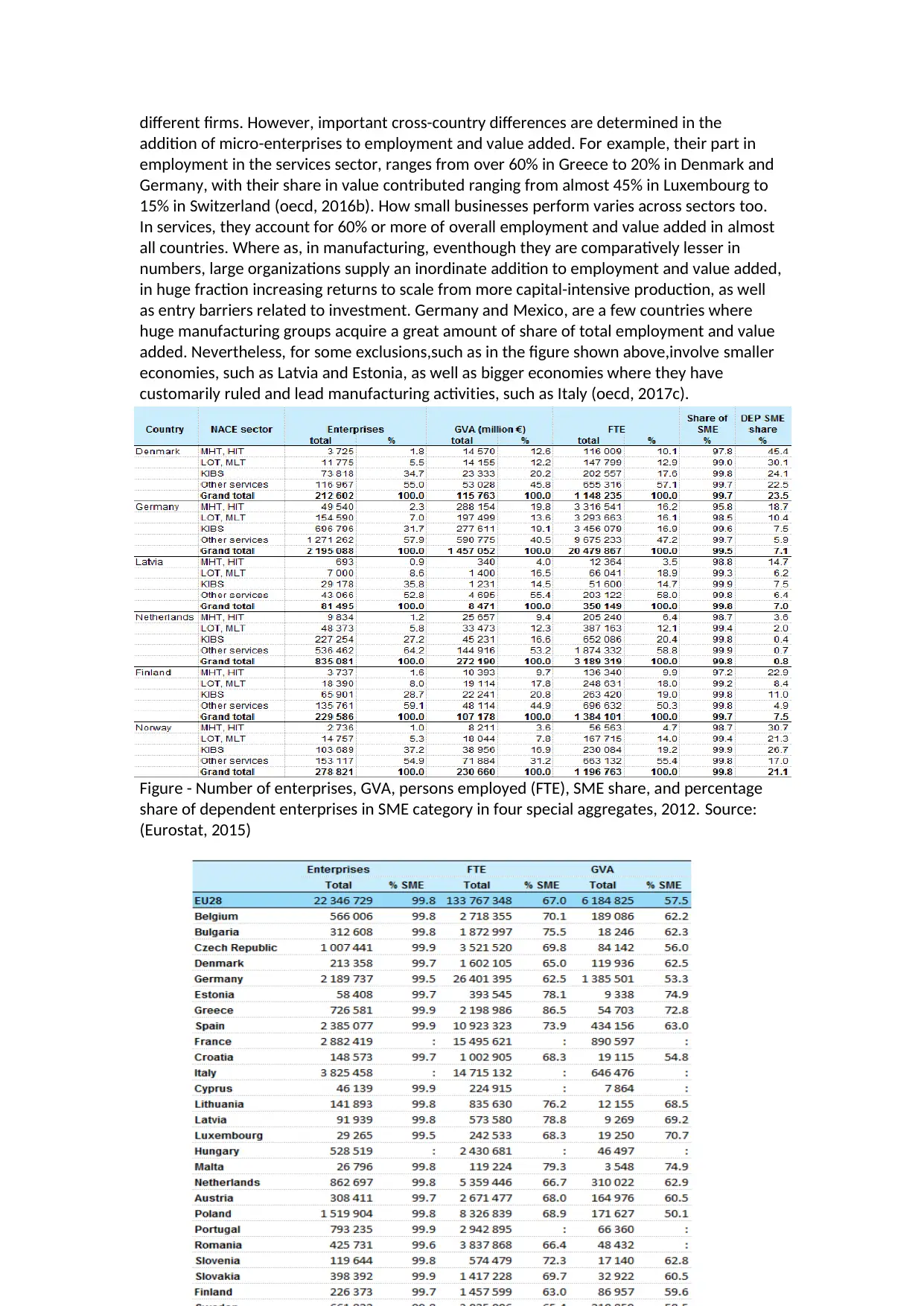
different firms. However, important cross-country differences are determined in the
addition of micro-enterprises to employment and value added. For example, their part in
employment in the services sector, ranges from over 60% in Greece to 20% in Denmark and
Germany, with their share in value contributed ranging from almost 45% in Luxembourg to
15% in Switzerland (oecd, 2016b). How small businesses perform varies across sectors too.
In services, they account for 60% or more of overall employment and value added in almost
all countries. Where as, in manufacturing, eventhough they are comparatively lesser in
numbers, large organizations supply an inordinate addition to employment and value added,
in huge fraction increasing returns to scale from more capital-intensive production, as well
as entry barriers related to investment. Germany and Mexico, are a few countries where
huge manufacturing groups acquire a great amount of share of total employment and value
added. Nevertheless, for some exclusions,such as in the figure shown above,involve smaller
economies, such as Latvia and Estonia, as well as bigger economies where they have
customarily ruled and lead manufacturing activities, such as Italy (oecd, 2017c).
Figure - Number of enterprises, GVA, persons employed (FTE), SME share, and percentage
share of dependent enterprises in SME category in four special aggregates, 2012. Source:
(Eurostat, 2015)
addition of micro-enterprises to employment and value added. For example, their part in
employment in the services sector, ranges from over 60% in Greece to 20% in Denmark and
Germany, with their share in value contributed ranging from almost 45% in Luxembourg to
15% in Switzerland (oecd, 2016b). How small businesses perform varies across sectors too.
In services, they account for 60% or more of overall employment and value added in almost
all countries. Where as, in manufacturing, eventhough they are comparatively lesser in
numbers, large organizations supply an inordinate addition to employment and value added,
in huge fraction increasing returns to scale from more capital-intensive production, as well
as entry barriers related to investment. Germany and Mexico, are a few countries where
huge manufacturing groups acquire a great amount of share of total employment and value
added. Nevertheless, for some exclusions,such as in the figure shown above,involve smaller
economies, such as Latvia and Estonia, as well as bigger economies where they have
customarily ruled and lead manufacturing activities, such as Italy (oecd, 2017c).
Figure - Number of enterprises, GVA, persons employed (FTE), SME share, and percentage
share of dependent enterprises in SME category in four special aggregates, 2012. Source:
(Eurostat, 2015)
⊘ This is a preview!⊘
Do you want full access?
Subscribe today to unlock all pages.

Trusted by 1+ million students worldwide
1 out of 26
Related Documents
Your All-in-One AI-Powered Toolkit for Academic Success.
+13062052269
info@desklib.com
Available 24*7 on WhatsApp / Email
![[object Object]](/_next/static/media/star-bottom.7253800d.svg)
Unlock your academic potential
Copyright © 2020–2025 A2Z Services. All Rights Reserved. Developed and managed by ZUCOL.





